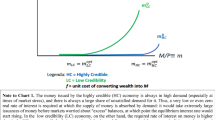Abstract
The paper uses cointegration analysis to investigate the demand for money in Switzerland in the context of an open economy. It considers the general process of financial asset substitution and tests for the relevance of an exchange rate and a foreign interest rate variable in a conventional money demand equation. The results show that the variables entering into the demand for either monetary base or narrow money equation may not form a cointegrated system unless the exchange rate or foreign interest rate variable is included. This provides support to both the currency substitution and capital mobility hypotheses.
Similar content being viewed by others
References
Arango, S. and I.M. Nadiri (1981) “Demand for Money in an Open Economy,”Journal of Monetary Economics 7, 69–83.
Bahmani-Oskooee, M. and M. Pourheydarian (1990) “Exchange Rate Sensitivity of Demand for Money and Effectiveness of Fiscal and Monetary Policies,”Applied Economics 22, 917–925.
Bell, W.R. and S.C. Hilmer (1984) “Issues Involved with the Seasonal Adjustment of Economic Time Series,”Journal of Business and Economic Statistics 2, 291–349.
Bernanke, B. and F. Mishkin (1992) “Central Bank Behavior and the Strategy of Monetary Policy: Observations from Six Industrialized Countries,” National Bureau of Economic Review, Working Paper No. 4082.
Boughton, James (1990) “Long-Run Money Demand in Large Industrial Countries,” International Monetary Fund, Working Paper Series WP/90/53.
Cuddington, John (1983) “Currency Substitution, Capital Mobility, and Money Demand,”Journal of International Money and Finance 2, 111–133.
DeJong, D., J. Nankervis, N. Savin, and C. Whiteman (1989) “Integration vs. Trend Stationarity in Macroeconomic Time Series,” Department of Economics, University of Iowa, Working Paper 89–99.
DeJong, D. and C. Whiteman (1991) “Reconsidering Trends and Random Walks in Macroeconomic Time Series,”Journal of Monetary Economics 28, 221–254.
Diebold, F. and G. Rudebusch (1991) “On the Power of Dickey-Fuller Tests against Fractional Alternatives,”Economics Letters 25, 155–160.
Engle, R.F. and C.W.J. Granger (1987) “Cointegration and Error Correction: Representation, Estimation, and Testing,”Econometrica 55, 251–276.
Ericsson, N.R. (1991) “Cointegration, Exogeneity, and Policy Analysis: An Overview,” Board of Governors of the Federal Reserve System,International Finance Discussion Papers, No. 415.
Fischer, A.M. and M. Peytrignet (1990) “Are Larger Monetary Aggregates Interesting? Some Exploratory Evidence for Switzerland Using Feedback Models,”Schwizerische Zeitschrift fur Volkswirtschaft und Statistik 126, 505–520.
Fischer, A.M. and M. Peytrignet (1991) “The Lucas Critique in Light of Swiss Monetary Policy,”Oxford Bulletin of Economics and Statistics 53, 481–493.
Fischer, Andreas (1993) “Is Money Really Exogeneous? Testing for Weak Exogeneity in Swiss Money Demand,”Journal of Money, Credit, and Banking 25, 248–258.
Fuller, W.A., (1976)Introduction to Statistical Time Series. New York: John Wiley & Sons.
Ghysels, E. (1988) “A Study Towards a Dynamic Theory of Seasonality for Economic Time Series,”Journal of the American Statistical Association 83, 168–172.
Hafer, Rick and Dennis Jansen (1992) “The Demand for Money in the United States: Evidence from Cointegration Tests,”Journal of Money, Credit, and Banking 23, 155–168.
Hendry, David and Neil Ericsson (1991) “An Econometric Analysis of U.K. Money Demand in ‘Monetary Trends in the United States and the United Kingdom,’ by Milton Friedman and Anna J. Schwartz,”American Economic Review 81, 8–38.
Heri, Erwin E. (1988) “Money Demand Regressions and Monetary Targeting Theory and Stylized Evidence,”Schweizerische Zeitschrift fur Volkswirtschaft und Statistik 124, 123–149.
Johansen, Soren (1988) “Statistical Analysis of Cointegrated Vectors,”Journal of Economic Dynamic and Control 12, 231–254.
Johansen, Soren and Katarina Juselius (1990) “Maximum Likelihood Estimation and Inference on Cointegration—with Application to the Demand for Money,”Oxford Bulletin of Economics and Statistics 52, 169–210.
Kohli, Ulrich (1987) “Exogenous Money, Disequilibrium, and Expectational Lags,”Kredit und Kapital 20, 179–199.
Kohli, Ulrich and Georg Rich (1986) “Monetary Control: The Swiss Experience,”Cato Journal 5, 911–926.
Kwiatkowski, D., P. Phillips, P. Schmidt, and Y. Shin (1992) “Testing the Null Hypothesis of Stationarity against the Alternative of a Unit Root,”Journal of Econometrics 54, 159–178.
Leventakis, J.A. (1993) “Modelling Money Demand in Open Economies over the Modern Floating Rate Period,”Applied Economics 25, 1005–1012.
McKenzie, C.R. (1992) “Money Demand in an Open Economy,”Journal of the Japanese and International Economies 6, 176–198.
McKinnon, Ronald (1982) “Currency Substitution and Instability in the World Dollar Standard,”American Economic Review 72, 320–333.
McNown, Robert and Myles Wallace (1992) “Cointegration Tests of a Long-Run Relation between Money Demand and the Effective Exchange Rate,”Journal of International Money and Finance 11, 107–114.
Mehra, Yash (1991) “An Error-Correction Model of U.S. M2 Demand,” Federal Reserve Bank of Richmond,Economic Review 77, 3–12.
Rich, Georg (1987) “Swiss and United States Monetary Policy: Has Monetarism Failed?” Federal Reserve Bank of Richmond,Economic Review 73, 3–16.
Rich, Georg (1990) “Exchange Rate Management under Floating Exchange Rates: A Skeptical Swiss View,”Journal of Banking and Finance 14, 993–1021.
Rich, Georg (1993) “Commentary,” Federal Reserve Bank of St. Louis,Review 75, 56–59.
Rich, Georg and Jean-Pierre Beguelin (1985) “Swiss Monetary Policy in the 1970s and 1980s: An Experiment in Pragmatic Monetarism.” In Karl Brunner (ed.),Monetary Policy and Monetary Regimes (Center Symposium Series C-17). (University of Rochester. Center for Research in Government Policy and Business, 55–70.
Rotheli, Tobias (1988) “Money Demand and Inflation in Switzerland: An Application of the Pascal Lag Technique,” Federal Reserve Bank of St. Louis,Review 70, 43–51.
Schiltknecht, K. (1983) “Switzerland: The Pursuit of Monetary Objectives.” In P. Meek et al (eds),Central Bank Views on Monetary Targeting. New York: Federal Reserve Bank of New York, 13–20.
Yue P. and R. Fluri (1991) “Divisia Monetary Services Indexes for Switzerland: Are They Useful for Monetary Targeting?” Federal Reserve Bank of St. Louis,Review 73, 19–33.
Author information
Authors and Affiliations
Rights and permissions
About this article
Cite this article
Chowdhury, A.R. The demand for money in a small open economy: The case of Switzerland. Open Econ Rev 6, 131–144 (1995). https://doi.org/10.1007/BF01001233
Issue Date:
DOI: https://doi.org/10.1007/BF01001233




